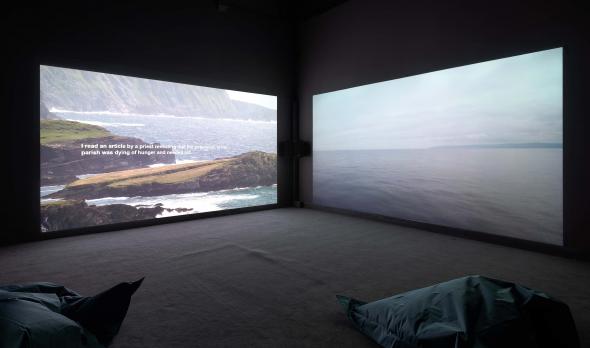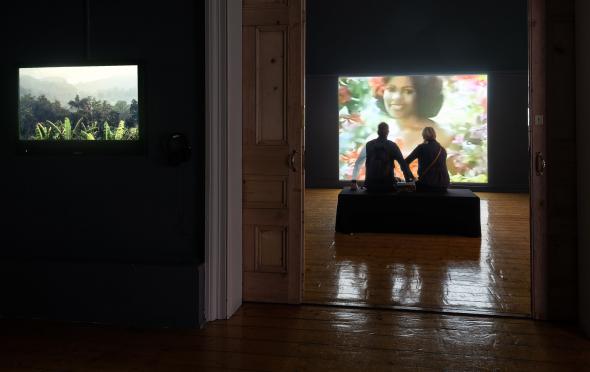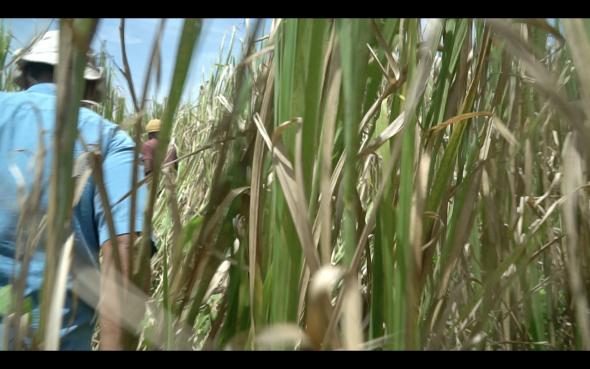Marianne Keating
Irish, London-based artist Marianne Keating addresses the connections between Ireland and the Caribbean in the context of both the British Empire and the present day. In the exhibition Better Must Come, she explores the largely unknown history of the Irish diaspora in Jamaica.
Keating examines the wave of immigration from Ireland to Jamaica, then British colonies, developed in the framework of the Caribbean’s plantation economy. She also considers the contemporary legacy of Irish settlement in Jamaica.
This wave of immigration occurred between 1835 and 1842, in the aftermath of the abolition of slavery. The economic hardships of the majority of Irish people under British rule offered fertile ground for recruitment of a new labour force to the Jamaican estates, which were struggling with a labour force shortage generated by the departure of the enslaved African population.
Many Irish committed to indenture, a contract – either signed or forced – binding them to an employer for a fixed period. Indenture was a system of servitude, given that work was exchanged for passage, housing and provisions instead of a salary. On completion of their term, indentured labourers were released from their contract.
Keating’s films bring together a range of archival materials – including government documents and photographs – found footage and extracts of written sources – from sociological essays to newspapers articles – with her own video recordings, interviews and field notes. She uses text as caption or voice-over to complement the image and sound, overlaying information to amplify the depicted perspectives.
Keating analyses the non-sequential manner in which the archive is navigated. Her approach to the disjunction of the archival record and the ‘enacted’ image/sound/text questions the legitimacy of the archive.
 Marianne Keating, Landlessness, 2017. Crawford Art Gallery, 2019. Fotografia Jed Niezgoda
Marianne Keating, Landlessness, 2017. Crawford Art Gallery, 2019. Fotografia Jed Niezgoda
Landlessness (2017) is one of the exhibition’s key works. Filmed on location in Ireland and Jamaica, this two-channel video projection is based on records held by the National Archives in Ireland, England and Jamaica. The script traces the path taken by a group of indentured labourers from Ireland to Freeman’s Hall, an estate in Trelawny, on the north coast of Jamaica.
One screen depicts Irish landscape overlayed with subtitles drawn from a 1835 dialogue between thinker Alexis de Tocqueville and John Revans, the Secretary of the Irish Poor Law Commission. Their conversation examines the roots and manifestations of destitution in nineteenth-century Ireland, locating its origins in colonial inequality between the Irish native – and catholic – population and the British – and protestant – settlers.
In parallel, the second screen shows vistas of the Atlantic Ocean and of inland Jamaica, overlayed with subtitles drawn from two other dialogues, one also from 1835 and the other from 1841. One the one hand, John Russell, head of the Colonial Land and Emigration Commission of the British government, and H. Hendricks, founder of the West India Immigration Society and representative of the Jamaican plantocracy, explain their reasons for renewing the labour force of the Jamaican estates with Irish indentured labourers. On the other hand, Charles Metcalfe, Governor of Jamaica, and John Ewart, Agent-General of Immigrants, discuss the complications of such immigration scheme, from the financial setback to the discontent demonstrated by the newly arrived Irish population.
 Marianne Keating, Better Must Come - A New Jamaica, 2019. Crawford Art Gallery, 2019. Fotografia Jed Niezgoda
Marianne Keating, Better Must Come - A New Jamaica, 2019. Crawford Art Gallery, 2019. Fotografia Jed Niezgoda
The exhibition’s other key work is Better Must Come – A New Jamaica (2019). This one-channel video is made with footage that Keating found online, drawn from British and Jamaican newsreels and Jamaican tourism advertisement clips, and footage that she shot in Jamaica. Keating mixes references to the founders and leaders of Jamaica’s two-party political system, Norman Manley and Alexander Bustamante – both of whom were of Irish descent – in the lead up to Jamaican independence in 1962. She follows the trajectory of the ‘new’ Jamaica, particularly the socialist-informed governing of Norman Manley’s son, Michael Manley, who served as Prime Minister of Jamaica from 1972 to 1980 and from 1989 to 1992.
A struggle between Manley and conservative leader of the opposition Edward Seaga ensued in the election of 1976, when Seaga was allegedly backed by the CIA in an operation to destabilize the Manley government in order to bring him to power. This conflict resulted in political violence in the country. Political violence in Jamaica grew with Manley’s government being swept from power by Seaga in the election of 1980, resulting in 844 murders. The fight between the conflicting ideologies represented by Manley and Seaga has since been shaping Jamaican society.
The exhibition also features three other films, all of which introduce aspects of Keating’s research. They Don’t Do Much in the Cane-hole Way (2019) focuses on Wilvie Balmer, a retired school teacher who descends from Irish indentured labourers. Balmer and Keating talk about the benefits of the local vegetation growing outside her house, where her family has lived since their arrival to Jamaica in the 1830s.
Journey to Kings Valley (2019) focuses on Kings Valley, the estate where the grandfathers of Alexander Bustamante and Norman Manley worked in the nineteenth century. Today, the property is abandoned, only accessible through dense overgrown cane fields which stand uncultivated due to the demise of the sugar industry, once referred to as ‘white gold’.
 Marianne Keating, Journey to Kings Valley, 2019. Still de vídeo.
Marianne Keating, Journey to Kings Valley, 2019. Still de vídeo.
Make the Economy Scream (2017) focuses on the burning down of a ward at the Eventide Home for the Aged, which was located in Admiral Town, once known as Admiral Pen. In the 1840s, this site was an immigration centre where Irish indentured labourers were housed. In an interview, news correspondent and writer Louis Wolf credits this incident to the CIA as part of its alleged attempt to overthrow Michael Manley’s government during the late 1970s due to Manley’s socialist agenda.
A new installation, We Know Where We Are Going: Vol. I, combines a vinyl record reproducing a political speech delivered by Michael Manley in 1976 with slides of Jamaica’s territory that Keating made or acquired in markets and online. Keating unites personal representations of Jamaica’s idyllic landscape with the social progress that Manley envisioned for the country.
Through her research, Keating accumulates the disregarded and overlooked traces of the Irish presence in Jamaica, inserting previously muted voices into the archive. In doing so, she critiques the dominant Western constructions of nationhood and identity, producing an alternative to the master narratives that shape one’ worldviews in the West.